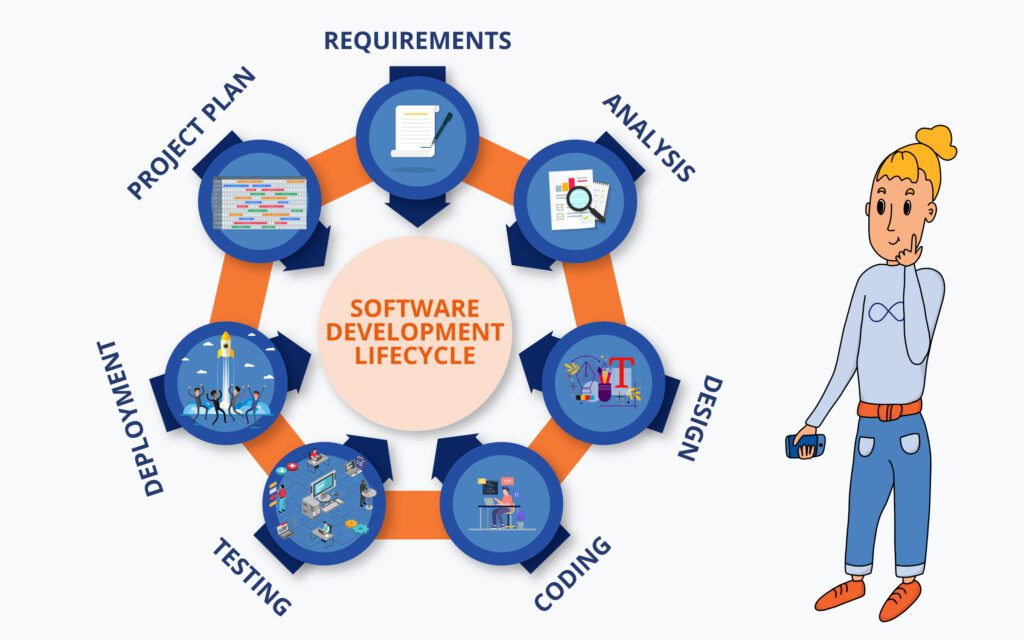Blog
Articles to grow your career
Article
How QA affects the software development life cycle
The software development process goes through stages. Before software is ready for use, it passes through a cycle during which the software testing is performed. While some experts believe that the software development life cycle involves five stages, some believe that it passes through six stages: Planning or Analysis, Design, Implementation, Testing, Deployment and Maintenance stages.
Regardless of the differing beliefs among experts, this article aims to explain how Quality Assurance affects the software development life cycle, whether five or six.
Required Analysis
Requirement Analysis is otherwise known as the planning stage. Here, the focus of the Quality assurance team is to get the requirements of a soon-to-be-produced software or the features of an upcoming version of an already-existing software. It is important to have a basic idea of the major features of the forthcoming performances or the new software.
Also, the QA tester(s) must be skilled in user experience, which is vital in developing a plan for the new features. Hence, they should identify potential glitches in the user experience that will likely affect the QA team’s progress. It is noteworthy that the performance of the Quality Assurance Team impacts the user experience as well as the design and the efforts channelled towards development.
Design
The performance of the Quality Assurance team in an organization is very vital in the design phase for many reasons. First, to ensure that the software’s design matches the organization’s standards. Also, the involvement of the QA team can save significant resources for the company.
Furthermore, the QA tester(s) will identify the parts of the design that will likely cause future usability glitches. For example, the prompt intervention of the QA team will inform the UI/UX design team to make appropriate changes on the fly (if need be), resulting in a more usable product and better user experience.
Implementation
At this stage, the project team focuses on writing source codes, and continuous testing is crucial. This is why it is recommended to keep checking components of the applications, like the module and object, to verify the state of the system operation. However, each of these components should be tested alone. This reliable method enables the tester to recode whichever component is found with a problem during this process.
Testing
The testing phase is the most important phase of the software development cycle. So, it is crucial to kickstart operations at this level. The Quality Assurance team, at this stage, monitors the testing software and activities like preparing testing status, prioritizing supported browsers, documenting bugs and testing bug fixes.
A QA tester must scrutinize all the software layers, searching for critical bugs and preventing scenarios where users might experience problems when using the software.
Deployment
At this stage, the code is passed to production. It is common to have cases where deployed codes have problems with design and functionality. To ensure that there won’t be glitches with the code after the deployment goes into production, the QA testers can do the smoke testing. Smoke testing is a software testing process that indicates the stability of deployed software. You can learn more about the smoke testing technique on spincareer.
Why QA is important in the software development cycle
The software development life cycle can be very technical and rigorous to produce a reliable product. Yet, it is vulnerable to hidden bugs, security attacks and errors in the absence of quality assurance. Therefore, quality assurance is very important to the cycle in many ways: it saves the company’s reputation, increases customer loyalty, and guarantees reliable security, amongst others. This section highlights the importance of Quality assurance in the software development cycle.
Do you want to join us?
Leave an application and get a free consultation from our manager.
- Help in choosing a direction
- Course consultation
- Additional materials for the start
QA saves your money and reputation.
The failure of a company to set up a Quality assurance team could be costly because there will be many undetected errors or hidden bugs. The accumulation of errors and bugs in software will hamper the company’s reputation. Regaining this reputation will require hiring a QA team to remedy the menace. This, in turn, will mean the company has to spend more money.
Setting up a QA team at the beginning software development cycle prevents costly repercussions that could arise from customer dissatisfaction.
i.e. If the users of a product are dissatisfied with the product, this could break the company’s reputation, making them inferior to the fierce competition in the tech industry.
QA increases customer loyalty.
The oversight of the QA team in the software development life cycle (SDLC) will inform the different departments involved in the process to avoid errors and to make appropriate changes. This will result in a better user experience. An excellent user experience will birth customer loyalty.
Again, the focus of any software development organization is to meet and surpass the expectations of the product end user’s experience. The absence of this could mar the reputation of the organization.
QA prevents emergencies
The diligence of QA analysts in an organization will prevent emergencies during the SDLC since they will have to intervene in every process of the software development cycle to rid the product of any error.
QA contributes to a larger number of sales.
There is a direct relationship between the sales of a product, the quality of a product and the QA team of the company. An excellent delivery can increase the sales of a product from the company’s development. The excellence of a product improves the reputation of the company. The reputation, in turn, increases the company’s confidence and clients’ confidence in the company’s product(s). These can be achieved by setting up a team of excellent QA experts. This structure is crucial to the achievement of a larger number of sales.
QA impacts the productivity of Employees.
Another role the Quality Assurance team plays is their influence on the software development life cycle rubs off on other employees. A primary skill required of a QA tester is paying attention to details. As the skill is developed in one’s career, coupled with the oversight of the Quality Assurance team in each stage of the cycle, other employees are compelled to deliver quality service. For instance, the vetting of the design made by the UI/UX team by the QA team indicates that the UI/UX team have done a good job. This applies to other employees in the company. The presence and diligence of the QA team ensure productivity in any company, shrinking the availability of time for frivolous activities or shabby service.
QA increases your Software Security.
With impressive user experience, excellent service delivery and an increased number of sales, there is still a probability that a software system becomes vulnerable if its security is compromised. Quality assurance helps in revealing compromises in the software’s reliability. Additionally, QA insists on the production of a reliable product.
Conclusion
Developing software involves five to six stages, depending on whether ‘maintenance’ is considered a cycle. However, in this article, five major phases of the software development cycle have been sufficiently explained. A company’s Quality Assurance must vet each phase before it proceeds to the next stage. Furthermore, this article has defined QA’s important roles in the software development cycle.
From this article, the value of QA engineers has been clearly explained. If you are contemplating switching careers, QA is a great suggestion. Begin your IT journey by taking any QA automation courses on spincareer.





